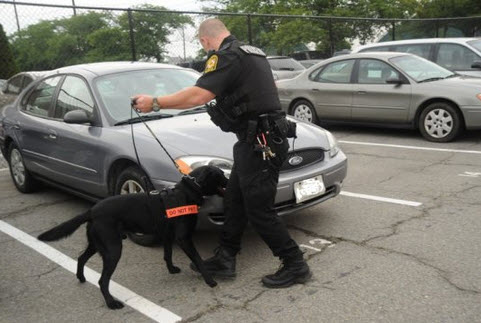[p1vc-video]
Tag Archives: dog training
Aggression When Another Dog Invades Her Space
Dear Adam,
Hi, I have a 3 year-old Australian Cattle Dog. She is a wonderfully obedient dog, canine good citizen certified and everything. She is very obedient and good-natured to people, however she is very dominant when it comes to other dogs.

Recently I have been having problems with her snapping at other dogs if they come up to her while she is on a leash. This is not a problem if I tell her to sit and the other dog stays a normal distance away.
She doesn't like dogs invading her space and standing over her (she is only 35 pounds, so most dogs tower over her). I call it her “Napoleon Complex”.
I tried to work on the problem by putting a muzzle on her and setting up situations so I can correct her, but she realizes that she is in no position to show the other dog who is boss while muzzled and refrains. We have recently started therapy dog training classes, which she is doing very well in.
Like I said she is a perfect angel around people. In a therapy situation she is unlikely to encourage other dogs on or off leash who will be allowed to be in a position close enough to upset her, however, if some instance did occur, I would feel uncomfortable with her snapping at another dog.
In most instances, I can prevent a situation where she would be tempted to snap from occurring, however, there are some instances that can't be avoided.
Do you have any suggestions? I'm debating whether I should discontinue her therapy dog classes.
Thank You,
Katie
Dear Katie,
This is really more of a handler issue.
It's your responsibility to NOT LET other dogs invade her space.
Now, you can correct her for the aggression – but at the same time, you must show her that she can trust you, and that you will not let strange dogs from another pack wonder up and get in her face. This is the job of the pack leader – to protect the pack.
You're not doing your job by letting strangers off the street walk up and get too close. I would recommend a walking stick or a stun gun.
As for the therapy dog training – I would recommend that you continue, but without seeing the dog in person, this will ultimately be a judgement call which you must make for yourself and your dog.

That's all for now, folks!
Adam
Train Your Dog – The Groundwork
Train Your Dog – The Groundwork
You should start training dogs as young as you possibly can. Puppies learn quicker and far from being cruel, it helps them to adapt and be happier animals.
It is absolutely essential that you get dogs into a routine before you can start any formal training, and this should include set meal times and walk times. If you let your dogs out in the yard then you should try to do so at a time when they need to go out.
Structure is Key
Some people express concern that training a young puppy is cruel. However, as its parent you are responsible for ensuring your dog learns right from wrong and performs the right actions at the right time.
Without a structured life and input from you, your puppy is likely to become down and depressed. Start young and start relatively lightly, there is certainly no need to start agility training immediately but you should learn a few basic commands.
For fast results, use high-quality, but inexpensive training treats.
Safe and Secure
Training your dog can also ensure it's future safety. For example an obedient dog is less likely to run away from home or run out into the street. Obedient dogs are usually exceptionally responsive to their masters call and therefore it is possible to keep them out of harms way.
Praise Pleases Them
You should always be prepared to praise your dogs when they do something you like. Initially you may want to include an edible treat as well, but in time you can and should revert to solely using verbal praise. By instilling these positive feelings your dog will be only too pleased to listen to your commands and aim to please you. This makes training very easy.
School?
Puppy training classes are excellent for giving you the groundwork to continue at home, and they also provide you with the perfect opportunity to socialize your dog in an understanding environment. Your puppy will get to meet other dogs and other people and you will be able to learn how he or she copes with the situation.
Fun Every Day
Don't believe that going to puppy classes once a week should be considered a fill training program for your dog though. You must continue with the training when you get home. Try to set aside some time every single day to carry on the training.
Free Gift
Grab our free Dog Training Encyclopedia as our gift. Learn, share, and reprint any portion you deem helpful to your project.
Please leave your dog training tips in the comments!
Dog Training Encyclopedia 2016
Dog Training Encyclopedia
12 Categories and 39 Articles with References and Resources that Expand.

SmallDogsUSA.org created a compilation of the most important information on dog training available for 2015.
The Dog Training Encyclopedia is comprised of 12 Categories and 39 Articles with references and resources that expand to complete the most thorough book on dog training available.
Whether you're a dog trainer or you just want to decode your dog's behavior, you will discover what you need to know inside.
Click on the image above for free Instant Access.
Our first thought was to offer this valuable resource FREE to our pawsome visitors. POUNCE ON IT WHILE IT IS STILL FREE!
This might be the first resource you check out prior to spending anything on books or courses or even considering hiring a trainer to help decode your dog(s) behavior.
After requesting your Dog Training Encyclopedia, another tab will open and present you with 173 two-column pages packed with so many topics that you are bound to discover something of extreme value for a happy relationship with your companion(s).
PRO TIP:
Easiest way to train a puppy or adult dog:
Step 1: Give a command (verbal, gesture, etc)
Step 2: Repeat until command is properly performed.
Step 3: Give Reward
To achieve best results be patient, repetitive and give a reward the animal will do anything for. Here's one the pros swear by.
Not only are they extremely effective, but they come with a money-back guarantee and customer support directly from the formulator. NOTE: Due to quality control standards, these training treats are only available direct from the manufacturer.
Tips for using the Dog Training Encyclopedia:
WINDOWS TIP: Use the ctrl+F key combo if you just want to find a particular topic fast.
EXAMPLES: SIMPLE KEYWORDS SEARCHED Found in the following Categories USING THE QUICK TIP:
-
Service Dog Training…1.2
-
Therapy Dog Training…1.2.2, 2.7, 2.22
-
German Shepherd Training…1.1, 1.1.4, 1.1.6, 1.9, 2.30.1, 2.36, 2.9
-
Dog Training Classes…1.1, 1.4.4, 1.4.5, 1.4.8, 1.4.9, 1.9.4
-
Puppy Training…2.18.3
-
Leash Training…1.1, 1.7, 1.7.2, 1.7.3, 1.7.5, 1.7.6, 1.9.4, 1.9.5, 2.8
-
Pitbull Training…2.22.6
-
K9…1.9.7, 2.22, 2.22.6
-
Police Dog Training…2.14.6, 2.16, 2.18.5, 2.22, 2.36
-
Dog Training Books…1.3
-
Border Collie Training…1.4.2, 1.6, 1.9.2, 2.29.2
-
Aggressive Dog…2.3.7
-
Guard Dog Training…1.1.4, 1.1.7, 2.16, 2.22
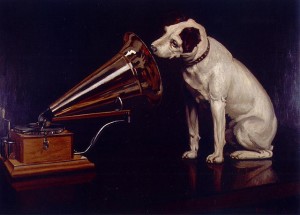
On the cover you'll discover the photo above. Here's the story:
The Nipper Saga
A little fox terrier sits inquisitively listening to his master's voice coming from the horn.
The famous painting is one ofthe world's most recognized and best loved trademarks.
The nipper logo made his first appearance in advertising in 1900.
Enjoy the story!
Nipper was a stray dog found in 1884 by mark barraud in bristol, uk.
When mark died three years later, Nipper (so named because of his tendency to nip the backs of visitors' legs) was taken to liverpool by mark's younger brother Francis, who was a painter.
Nipper discovered the phonograph (a cylinder recording and playing machine) and Francis Barraud often noticed how puzzled he was to make out where the voice came from.
This scene must have been indelibly printed in Barraud's brain, for it was three years after Nipper died (in september 1895) that he committed it to canvas.
In case you missed the link, here it is again. Download
According to the Dog Training Encyclopedia, Here are the Top 10 Smartest Dogs
Brightest Dogs
Understanding of New Commands: Fewer than 5 repetitions.
Obey First Command: 95% of the time or better.*[18]
1. Border Collie
2. Poodle
3. German Shepherd
4. Golden Retriever
5. Doberman Pinscher
6. Shetland Sheepdog
7. Labrador Retriever
8. Papillon
9. Rottweiler
10. Australian Cattle Dog
UPDATE: Resource Added…
Find a Local Dog Trainer or Canine Professional
Dog Training Has a Deep History–What’s Next?
Some Deep Insight On The History of Dog Training
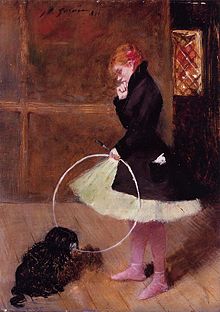 Thanks to Terrierman's Daily Dose for the extensive insight to dog training and its evolution.
Thanks to Terrierman's Daily Dose for the extensive insight to dog training and its evolution.
Read to the end, and you may change your mind about considering dog trainer as a lifetime occupation.
If nothing else you can expect a smile from the comment left.
In all seriousness, there are many aha moments that make this post worth sharing by including it in our careers category.
1915: Baltimore police begin using Airedales from England to patrol the streets. The police suspend use of Airedales in 1917 as the dogs had helped make no arrests. The police failed to notice that no robberies had occurred where the dogs were on patrol.
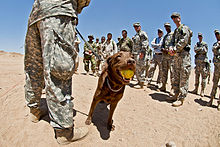
1915: Edwin Richardson trains dogs for the military during WWI using some positive reinforcement, and the dogs prove to be quick studies. Many dogs are used for communication and for guard duty.
1917: The Germans begin to formally use dogs to guide soldiers blinded in mustard gas attacks. The French soon follow suit.
1918: U.S. Army Corporal Lee Duncans find an abandoned war dog station in Lorraine, France which has five young puppies in a kennel. Duncan takes one of the pups and names it “Rin Tin Tin” after the finger dolls that French children were giving to the soldiers at the time. The dog travels to California, proves easily trainable, and is soon employed making movies that are so successful it saves Warner Brothers studio from bankruptcy. The dog dies in 1932 in neighbor Jean Harlowe's arms, and is buried in Paris, but its descendents work in the movies throughout the 1950s, inspiring many people to try to train their own dogs to do simple tricks.
1925: One of the very first German-trained guide dogs for the blind is given to Helen Keller.
1926: Propelled in large part by the popularity of Rin Tin Tin, the German Shepherd population in the U.S. explodes, and by 1926 it accounts for 36 percent of all the dogs in the AKC — 21,659 animals. Due to rapid inbreeding and poor selection, however, the American German shepherd quickly degenerates and is soon deemed inferior.
1929: Dorothy Harrison Eustis establishes the Seeing Eye Foundation to train guide dogs for the blind. Eustis goes to Switzerland to get a better stock of German Shepherds than she can find in America. This same year the AKC tries to ban the importation of foreign purebred dogs in order to protect domestic dog breeders, but the plan fails.
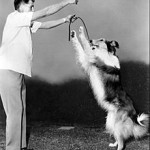
1930: About 400 dogs are employed as actors in Hollywood, the majority of them mongrel terriers which prove to be small enough for indoor scenes, rugged enough for outdoor scenes, and exceedingly smart.
1938: B.F. Skinner begins research into operant conditioning as a scientifically-based learning model for animals and humans. His special focus is on teaching pigeons.
1939: The AKC begins obedience competitions designed by Helen Whitehouse Walker who wants to prove that her standard poodles can do something other than eat food.
1942: The U.S. military says it needs 125,000 dogs for the war, and asks people to donate their large breeds. The military manages to train only 19,000 dogs between 1942 and 1945. The Germans reportedly had 200,000 dogs in service.
1943: In 1943, Marion Breland and her husband Keller Breland form a company called Animal Behavior Enterprises (ABE) to teach animals for shows. The Brelands had been students of B.F. Skinner (see 1938) and began teaching animals to perform tricks for shows and for commercial clients such as dog-food maker General Mills.
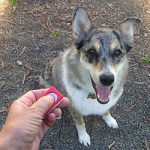
They pioneer the use of a “clicker” to teach animals at a distance and to improve timing for affirmations and delayed rewards. The Brelands were the first people in the world to train dolphins and birds using operant conditioning.
1943: The movie “Lassie Comes Home” is filmed, featuring a purebred male collie playing the female staring role. Ironically, the U.S. military considered purebred (i.e., AKC ) collies so stupid that they were specifically excluded from military service in World War II, while herding farm collies were actively recruited.
1947: The Brelands (see 1943) begin using chickens as learning subjects with which to train other trainers, as they are cheap, readily available, and “you can't choke a chicken.”
1953: Austrian animal behaviorist Konrad Lorenz writes “Man Bites Dog” and “King Solomon's Ring,” books which popularize animal behaviorism.
1954: Baltimore reestablishes its police dog program, and today it remains the oldest police K-9 program in the country.
1960s: During the early part of the 1960s, Marian and Keller Breland (see 1943) are hired by the U.S. Navy to teach other animal trainers how to train dolphins. The Navy is interested in using dolphins to patrol harbors, retrieve lost gear, and guide bombs (i.e. “suicide bomber” dolphins). During their work with the Navy, the Breland's meet Bob Bailey, the Navy's first director of animal training, and they began a partnership with him. Keller Breland dies in 1965, and in 1976 Marian and Bob Bailey are married.
1962: William Koehler publishes “The Koehler Method of Dog Training” which becomes a staple of AKC obedience competitors. Though often criticized today, Koehler's methods are the core of a lot of effective dog training systems still in use.
1968: Sensitronix, Tri-trinox and Jetco come out with electronic collars for hunters. These are not dog training tools, but high-powered shock collars designed to bust dogs off of “trash” chasing of unwanted game, cars, and bicycles. The collars have one switch, and voltage is adjusted by changing out the “cartridge,” i.e. the capacitor inside the collar.
1970s: The U.S. Customs Service begins to use dogs to detect drugs, and they are subsequently employed to sniff out explosives and fire-starting chemicals.
1971-72: Richard Peck, a traveling salesman in Pennsylvania, develops a pet containment system which is a cigarette pack-sized receiver that fits on a collar with electronic prongs touching the animal's skin. The battery in the collar charges a capacitor which discharges when triggered by a radio signal coming from a perimeter wire. Manufactured by the Sta-Put Sales Co.
1972-73: The first electronic bark collars are marketed by Relco and Tri-tronics.
1976 – John Purtell purchases the patent for a radio collar pet containment system from Richard Peck and changes the name of the company to Invisible Fence, building the company up until he sells it in 1993 at about the same time as the patent expires.
1978: Barbara Woodhouse publishes “No Bad Dogs” one of the first popular books on basic dog training. It relies heavily on proper use of a choke chain, and says most “bad dogs” have inexperienced owners who are not training their dogs properly by being consistent, firm and clear.
1984: The U.S. Dept. of Agriculture begins to use beagles to patrol airports for contraband food and other perishable items.
1985: Dolphin trainer Karen Pryor publishes Don't Shoot the Dog: the New Art of Teaching and Training which focuses on timing, positive reinforcements and shaping behavior, and draws heavily on the work of Marian Breland Bailey and Robert Bailey (see 1943 and 1960s). Her book promotes “clicker training” of dogs to improve timing and to allow trainers to communicate and “reward” their dogs from a distance.
1995: The U.S. Dept. of Agriculture begins using Jack Russell Terriers to locate and kill invasive brown tree snakes on the island of Guam.
2000 and beyond: Various cable television shows feature various dog training and rehabilitation methods. The notion that there are “new” and “old” dog training methods obscures the fact that ALL dog training methods involve some form of operant conditioning which is, in fact, pretty old stuff (as old as dogs). None of the dog training shows actually explain the core principles of operant conditioning or their relative worth in different training situations.
2000 – Rapid improvements are made in the the world of e-collars which can now come with tone, vibration, and hundreds of variable levels of electrical stimulation, making them potentially less aversive than old-fashioned flat collars and leashes. The use of old and poorly made collars, combined with poor dog training skills by those who think e-collars are a “quick fix” for any and all problems slows their adoption, as does demonization by “dependency model” and trick-dog trainers.
2035 – First robotic dog trainers appear. These machines are the size of an upright vacuum cleaner and are capable of teaching a dog basic obedience (sit, stay, come, heel, go out to place, etc.) as well as simple tricks (roll over, play dead, speak) . These simple robots are little more than BF Skinner teaching machines on wheels, providing diverse food awards and mild electrical stimulations, as well as tone, vibration, and visual cues. Powered by powerful internal batteries and artificial intelligence, they track the location and position of the dog, give human voice commands, and can be programmed to guide a dog through adaptive learning sequences. Infinitely patient, and with perfect timing and consistency, they revolutionize the world of dogs and lead to dramatic declines in canine euthanasia.
This post was followed by 1 comment that adds food for thought for the evolution of dog training:
2036 – A dog owner was attacked and killed by two small brown and white dogs in her home this afternoon. State surveillance video taken just before the attack showed her trying to switch off the power to her robotic dog trainer, which had been the dogs' only company for the previous month while the owner was on vacation.
Credits: Terrierman's Daily Dose: A Brief History of Dog Training
